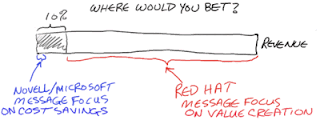07 Apr The Subscription Model: A license to kill
- Official or legal permission to do or own a specified thing.
- A document, plate, or tag that is issued as proof of official or legal permission.
- Latitude of action, especially in behavior or speech.
- To grant a license to or for; authorize.
Dave Rosenberg recently discussed some of the customer confusion caused by the pervasive open source concept of software subscriptions. I believe his comments only explain 1/2 of the confusion. The experience I have had with CIO’s is in their confusion regarding where and how a “license” fits into the subscription concept. Not only do they typically not understand the nuances of the various open source licenses, but they also have a natural bias toward a traditional understanding of a license as a “right to use“. Meaning, that if you do not pay the license you cannot use the software. This appears contradictory and confusing to their notion of open source software and its many inherent “freedoms”.
A couple of my thoughts based on experience:
1) Price vs. Value (outcome/price). Most open source companies “tout” the no license fee mantra to customers. This is natural as most customers begin looking at open source alternatives in the first place for the expected cost savings – and they can usually find them. Typically, the OS company will lead with, “we are great because we don’t have a license fee.” However, leading with the price alone boxes you into the corner of cost savings and the subsequent TCO FUD studies that create even more confusion for customers. The license fee savings is only a small part of the overall savings (typically from 10-20% of overall cost of ownership). More importantly, selling in this fashion does not harness the true value of Open Source:
I am sorry but I can’t remember where I pulled this from. Please attribute this to the right person.
Open source is so much more than a cost saving method. It is a method of innovation, of development, of distribution, and a corporate philosophy. It inherently is about collaboration, community, and creating value for customers. It is capitalistic Darwinianism – may the best technology, products, and service win in an open, transparent, and value based competition. That’s really the message and impact of the above graphic.
2) Definition of Subscription: Right to Use the Software vs. Right to Use the Service. Dave’s idea to “re-package” or bury the same license fee under either the label of a Subscription model (license and support bundled) vs. the Traditional model (license with support separate) seems paternalistic and misses the source of confusion. Worse, I believe marketing to your customers that you don’t have a license fee while you clearly have one (albeit buried under some other name) is dishonest, misleading, and not in the spirit of open source.
The real question for customers regarding the license is really around the “right to use”. Customers want to know that if they implement your open source software what will happen if they opt to not continue the subscription service? Does the software go away, does it get pulled, does it become inoperational, or what? That is the question burning in their minds.
This is obviously important – particularly because there are divergent OS business models that use the “subscription” term. Most OS companies give away their software and then sell their professional services (implementation + support). A theoretical and practical reality of OS software is that the OS Vendor has to provide value to the customer or customer will not renew their agreement. In the proprietary world, that means that your software goes away; in the OS world it means your support goes away. The switching cost of swapping out your software versus swapping out your service provider are dramatically different, and part of the reason why OS vendors work so hard to differentiate their services and focus so sharply on value creation for their customers.
As an example of this definition and this concept of Subscription as a Right to Use the Service, Red Hat offers Subscriptions that provide customers “ongoing service” as defined by updates, enhancements, and support as part of the Red Hat Network. However, your right to use the Red Hat software currently installed is never in question. The value of the subscription then, and the innovation driver for Red Hat, is that they must continually improve, enhance, and increase the value they are delivering as part of their Red Hat Network subscription service, or their customers don’t renew. The fact that Red Hat’s subscription renewal rate is >95% attests to the fact that their customers are answering the value question overwhelmingly in the affirmative.
So an open source business – leveraging a s
ubscription (right to use the service) model – inherently is under more competitive forces to drive both innovation and ongoing value creation for customers. And that is the license to kill inherent in the open source subscription model.



Anonymous
Posted at 12:42h, 09 AprilYou got the graphic from
http://stephesblog.blogs.com/my_weblog/2007/03/novells_link_to.html